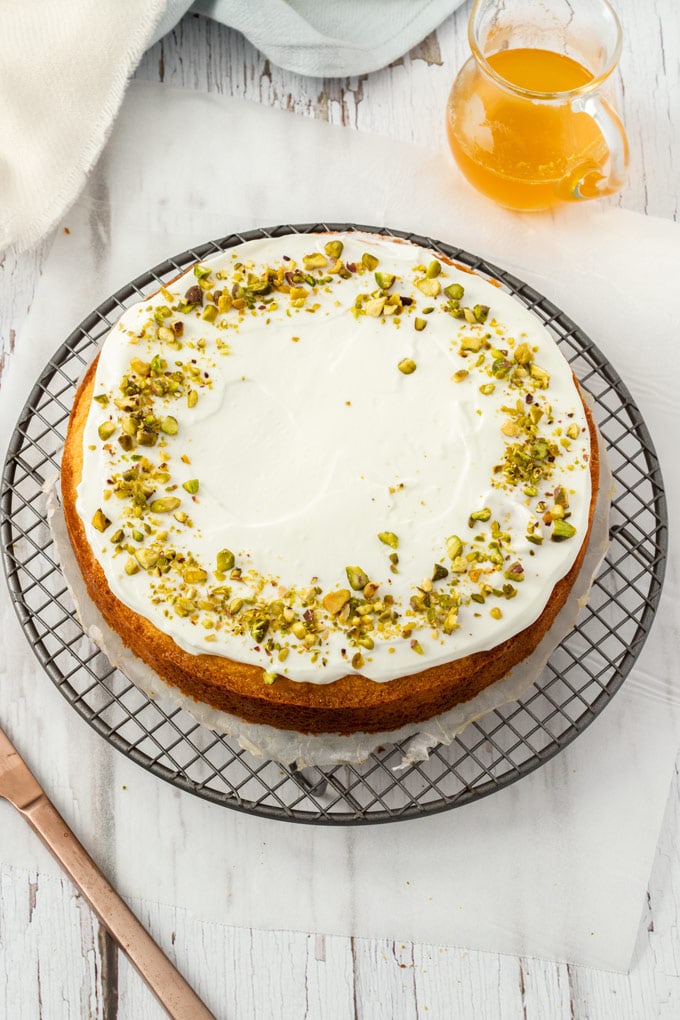I just adore this Greek Orange Semolina Cake, with its sunny citrus flavour (please tell me I’m not the only person who describes citrus as ‘sunny’) and luxuriously soft and moist texture, this cake is a must try.
If you prefer cakes on the lighter-texture side, you’ll love this one, alongwith my Fluffy Vanilla Cake and Lemon Vanilla Butter Cake.

Table of contents
I’ve made this semolina cake a number of times now and it turns out beautifully every time. The orange flavour, from orange juice, zest and a sweet orange syrup is undeniable and absolutely addictive.
What is semolina flour and what is semolina made from?
Semolina flour is a flour ground from durum wheat, as opposed to the ‘soft’ wheat used to make regular milled flours like plain and all-purpose.
Semolina flour can be ‘course’ or ‘fine’ – you will need fine semolina for this recipe.
Is semolina flour gluten free?
No. Semolina flour is still made from a type of wheat and contains gluten.
Why use semolina flour in a cake?
Semolina flour is more course than regular white milled wheat flours, and in this Greek Orange Semolina Cake it results in a chewier texture and also gives a slight nutty flavour.
Is there a substitute for semolina flour in baking?
You can swap the semolina flour for standard plain or all-purpose flour in most cases but it will alter the texture and flavour slightly.

How to make semolina cake
I use a stand mixer but you could do it with a handheld beater or by hand if you have the upper arm strength I don’t for creaming butter and sugar.
- Start by creaming together butter and sugar until lightened and fluffy.
- Next, add the eggs one at a time and beating well after each one. Make sure you scrape down the sides of the bowl regularly too.
- In one bowl mix the dry ingredients and in the other mix the orange juice, zest and vanilla. Now add these to the mixture in 5 additions, alternating between each – dry, wet, dry, wet, dry.
Don’t be worried if the batter looks split at any point – that’s perfectly fine and will not affect the final cake. There are a few things at play here being eggs and sugar reacting and then the acid and oils in the juice and zest.
- Spread the thick batter out into a prepared 8 inch spring form tin and bake for 40-45 minutes.
For the orange syrup
- This sweet orange syrup is a simple case of adding orange juice and sugar to a saucepan. Let the sugar dissolve over low heat
- Then, let it come to a simmer for a minute or two until it reduces by half.

Substitutions
- Orange: Swap out the orange for lemon instead or a combination of both for a delicious citrus cake
- Plain flour: You can swap out the semolina flour for plain flour, however it will have a slightly different flavour and texture.
- You could also swap the plain flour for almond meal (flour) to give it an almond flavour and denser texture.
- Orange syrup: swap the orange syrup for a little honey instead.
- Lemon Semolina Cake: with thanks to reader Dianne for her feedback, this cake can also be turned into a Lemon Semolina Cake by simply substituting the orange for lemon. For that matter, try any citrus and it will work out lovely.
You could also think about topping this cake with these stunning candied orange slices too.
Tips for best results
- Make sure to let the syrup cool before adding it to the cake or it may just make it soggy (but even the soggy bits taste glorious)
- If the syrup is too thick (this may happen if you cooked it a little too long) no problem. Just add a little water and mix it through. You may need to do this over heat to incorporate it properly.
- Use a fork to poke holes in the cake – this will allow the syrup to seep down here and there all over the cake.
- If the cake has a little dip in the middle, make sure not to let the syrup pool there for too long. Use a pastry brush or even just a spoon to spread it over the whole top of the cake.
- Don’t swap the yoghurt for buttercream – you may be tempted if you aren’t a fan of yoghurt but you’d be better off serving it without. The yoghurt adds a gorgeous tanginess that balances the sweetness of the cake and syrup.
PIN IT:
Click to Pin this recipe for later!

Pinky promise, you will love this Greek Orange Semolina Cake recipe. It’s easy to make and with just yoghurt for topping it’s also fairly quick in cake land
Just like my Blood Orange Loaf Cake or this gorgeous Orange and Poppy Seed Bundt Cake, this cake is perfect for both afternoon tea and dessert. It’s rich and luscious, a slight soft denseness if that’s a thing. Hard to describe but supremely easy to eat, you need to try this asap.
Other recipes you might like
- Lemon Ricotta Cake
- Mini Flourless Ginger Orange Cake
- Orange Cupcakes with the Creamiest Orange Buttercream
- Flourless lemon cake
- Baklava Frangipane Tart
- Vanilla Panna Cotta with Orange Syrup
- Lime and coconut cake
Never Miss a Recipe!
Get the latest recipes straight to your inbox!

Ingredients
For the cake
- 160 g fine semolina flour (1 cup / 5.6oz)
- 130 g plain (all-purp) flour (1 cup / 4.5oz)
- 2 teaspoons baking powder
- Pinch of salt
- 100 ml orange juice
- Zest 2 medium oranges, finely grated
- ½ teaspoon vanilla extract
- 226 g unsalted butter, softened (2 stick / 1 cup)
- 250 g white granulated sugar (1 ¼ cups / 8.8oz)
- 3 large eggs, room temp
For the syrup
- 100 ml orange juice
- 100 g white granulated sugar (½ cup / 3.5oz)
For the topping
- ¾ cup natural Greek yoghurt
- Handful of crushed pistachios
For best results, always weigh ingredients where a weight is provided
Equipment
- A stand mixer or hand held beater
Instructions
FOR THE ORANGE SEMOLINA CAKE
- Preheat oven to 180C / 350F / 160C fan forced. Grease and line an 8 inch spring form tin with baking paper.
- Place the semolina flour, plain flour, baking powder and salt in a bowl and whisk to combine.
- Combine the orange juice, zest and vanilla and set aside.
- In the bowl of a stand mixer, beat together the butter and sugar until very light and fluffy. Scrape down the sides of the bowl as required.
- Add the eggs one at a time and beat well after each to combine and scrape down the bowl after each addition.
- On the lowest speed or with a spatula, gently fold in 1/3 of the flour mixture, followed by 1/2 the juice mixture and repeat until all added and only just combined.
- Tip the thick batter into your prepared tin and bake for 40-45 minutes until a toothpick comes out with just a couple of crumbs. After about 5 minutes remove from the tin and allow to cool completely on a cooling rack.
FOR THE ORANGE SYRUP
- Pour the orange juice and sugar into small saucepan over low heat and mix gently until the sugar has dissolved. Bring to a low simmer until reduced by half.
TO FINISH
- Once the cake and syrup have cooled, prick the top of the cake with fork here and there. Pour over about half of the syrup (reserve the rest for serving). If the syrup pools in the centre use a pastry brush or spoon to spread it out.
- Spread the yoghurt over the top and sprinkle over the pistachios. Serve with remaining syrup.
Notes
- For best results, you should always weigh ingredients like flour and sugar. Kitchen scales are relatively cheap but if you can’t weigh the ingredients, use the spoon and level method (don’t scoop).
- If the batter looks split at any point, don’t worry – it will bake up fine.
This post may contain affiliate links that earn me a small commission for my referral, at no extra cost to you. Thank you for supporting Sugar Salt Magic.






80 Comments on “Greek Orange Semolina Cake with Orange Syrup”
This cake is awesome, my greek sons loved it.. Thanks it was amazing…
So happy to hear this, Elaine. Truly appreciate you dropping back to leave a review 🙂
Greek Lemon Semolina Cake with Lemon Syrup….superb!!!
Sounds fantastic, Fiona.
This is my go to recipe it’s lovely. Do you think it would freeze well?
Hello Jadearra. So happy you love it and yes, it will freeze fine without the topping.
I have done the cake & it turned out well. Fantastic recipe. Now I am asked to do the cake without eggs. Is the possible & what can i substitute for the eggs? Thank u
So happy you love it, Maddy. I’m sorry but I don’t specialise in egg-free baking so I couldn’t say exactly. There is such a thing as flax eggs but they don’t bind quite as well in baking as a regular egg. You can also buy egg replacer but, again, I’m not sure if it would be a simple swap. Let me know if you try it.
I made this yesterday. followed the recipe exactly but I could not find a 8 inch spring form pan so bought an aluminum professional cake pan. Instructions on the pan said to lower the cooking heat by 25 degrees which I did to 325F. Cake went in the oven and was rising beautiful and then when I looked again it had totally sunk in the middle. I had to leave it in the oven a bit longer to cook the middle.
Served the cake upside down as it looked better. Made the syrup and poured all of it over. It soaked in well. Everyone enjoyed the cake especially good with the greek yogurt and nuts. I just served that with a dollop on each slice. I live in Alberta, Canada. I was wondering if the high altitude had anything to do with the cake collapsing or maybe I over mixed the butter and sugar? I did not find the cake too light but it was not overly heavy either. I will try and make it again when I do another Greek dinner.
Hello Kim. The cake does turn out with a slight dip in the middle but it should not totally sink. I would say changing the temperature would have something to do with it. Even though the cake pan says to do that, that method is not necessarily going to work with every recipe perfectly. Happy you enjoyed it though.
Thank you for answering my question. I am going to make this recipe this weekend. Hopefully it will turn out.
Hi again, Could I use Almonds Instead of a Handful of Pisachios?
Absolutely. It’s just for the topping so you can use any nuts you like 🙂
I have a bag of Semoule #1 would that be good to use in this recipe? It does not say on the bag if it is fine Semoule.
Hello, it’s not a name I’m familiar with though I Googled a picture and it looks right. It should just be as fine as flour.
My sister-in-law,who never eats desserts, said my Greek Orange Semolina Cake was a SHOW STOPPER! Everyone complimented how lovely it tasted. I’ve never received such compliments before!! I’ll need to make it again!
I’m so happy you love it, Joy. Truly appreciate you dropping back to leave a review.
Wow this is one of my favorites! I was very skeptical about the yogurt but it is a must! drizzling the orange syrup over it was delicious!! took this to a greek dinner with 15 people and they all loved it .
I’m so happy you all love it, Anna. Thanks so much for dropping back to leave a review too 🙂
This cake was true to recipe and description. I used 1 stick butter and 6tbl olive oil. I also didn’t do the yogurt topping. The cake was very moist and full of citrusy flavor-I used blood oranges. The center sank a little, I baked for 55 min at 350 bottom rack. I brushed on all the syrup, no reserve. Perfect cake to go with a rich cup of cappuccino or Turkish coffee, a real winner!
So happy you love it, Elena.
Hi, would this work if I substituted the flour with gluten free flour?
Hi Nicole. Technically, yes, however I’ve found GF flour brands to all have varying degrees of success in baking. I’m not sure if you can get it but I like Orgran brand when I can get it.
I made double recipe (ambitious I know!) as we have friends coming over for coffee this evening. They both sank a little in the middle but nothing serious. I sliced one of them this afternoon and it’s sooooo good! I see me making this again and again. Thank you for sharing your recipes!
So happy you love it, Sandra 🙂
Hi I tried the semolina orange cake without the yoghurt topping today. Turned out so good. I added orange blossom water instead of vanilla. Thank you it’s delicious 💕
Great to hear, Misriya. So happy you love it.
I’m curious how long this could keep in an airtight container. If I made it on a Wednesday, could I serve it Friday (adding the toppings and bringing it to room temp when it was served)? Any thoughts?
Hi Emil. Yes, it will keep fine exactly as you’ve suggested. You can add the syrup now or later, but leave the yoghurt off until serving time.
I have made your orange semolina cake twice now and hubby absolutely 💯 percent loves it. It is now in my cake repertoire. I omitt greek yoghurt and put all the syrup on the cake once cooled.
Thanks so much, Olivia. I’m so happy you love it.
Any idea how to adjust for 6,000 feet altitude?
Hello Shannon. I don’t personally have the experience to say but I found this fantastic resource by King Arthur Baking. Hope it helps.
Thank you for recipes,I was thinking about baking something with semolina but didn’t have much courage,now I do.Thank you
There is this 1ltr milk ,9 tbl spn sugar and 9-10 tblspn semina toping I like it with lots of orange and lemon zest, haven’t tried it yet but I am sure it would go amazingly well with your orange semolina.
I’m so happy and that topping sounds intriguing!
Great cake, super easy to make and very flavorful. Suggestions on best way to store it? Is it okay to add the yogurt and let it sit on the cake overnight?
Don’t skip the yogurt and pistachios! They make the cake perfect.
Hi Brianne, so happy you love it. It’s best stored in the fridge in an airtight container and overnight will be fine. It can be frozen, without the topping too.
I don’t have a springform pan. Has anyone tried using 2, 8″ cake tins? Or would a 9″ pyrex pie dish work? Thanks!
Hi Diana. An 8 inch tin will work. If yours only has short sides, line with baking paper so the paper sits higher than the edge of the pan.
I cannot find a 8″ pan. Can i use a square one?
Hi Kim. It should work fine though may not take so long to bake.
Really nice moist flavoursome cake. Substituted ground almonds as I had no semolina. Making again today with semolina.
So happy you love it Barbara.
I’m making this for a lunch party at the weekend. Would you recommend making it the day before (and icing the next day) or on the morning of the party? Would the syrup keep it from drying out overnight if it was in an airtight tub?
Hi Brigid, it will be fine made the day before and stored in an airtight container. Top on the day you’re serving it though. Happy baking
The cake is heavenly, to say the very least. There are so many layers of beautiful flavors and it’s just so beautiful that each layer compliments the other. Thank you for sharing this.
Thanks so much Hani. This makes my day to hear.
Hi there!
Do you know if this recipe would work in a loaf pan? I’m new to baking, so forgive me if the answer is really obvious.
Thank you!
I’m sorry Joshua, I haven’t tested how it turns out using a loaf tin. If it’s all you’ve got though, go for it, just make sure not to overbake it – loaf pans tend to cause cakes to overbake quickly.
Hello, I was going to try this but have a question. Is Semolina #1 considered flour? I have some but don’t know if this is just semolina or if it’s semolina flour.
Thanks
Hi Regina, I’m not sure about Semolina #1 – it might be a name a particular brand uses. What you’re after is a flour-like semolina, not the courser grade. Hope that helps.
I am so glad I found this recipe, I’ve made it twice in about as many weeks. So delicious!
I’m keen on trying a lemon version next, would that mean 100ml of lemon juice in the cake mix? Or would that peel the enamel off my teeth…?
So happy you love it Maureen. I’m not entirely sure about how much lemon as I haven’t tested this. It’s something that’s on my list to try though, so I’ll update here when I do.
I made this for our Easter dessert this year, using orange, lemon and lime. It was perfect, and so beautiful!
So happy you love it, Teri
This is an absolute winner recipe if you’re looking for something different.
Thanks so much Ronel. So happy you love it.
Hi,
Could I substitute semolina for semolina flour? Or would it make it too gritty? Could I just add some ground almonds to normal flour to get the texture?
I’ve made this before with semolina flour but don’t have any and can’t find it in the shops.
No, it will give a completely different texture. Just substitute for regular plain or all-purpose flour
I was wondering what to make from the remainder oranges lying around. Stumbled upon this recipe and made this cake last week. Simply delicious and those who ate it had a resounding yes to keeping this as a keepsake recipe. The only thing I changed was the temperature to 160 as I saw the cake browning too fast.
I’m so happy you loved it Shila
Hi I have made this cake a few times now and it gets better and better I put my own twist and instead of flour I used ground almonds omg it was so tasty as my girlfriend does not like flour I am just making a nother one as I am typing this message the whole house is filled with the aroma of the orange syrup as I put a splash of grand marinier in the syrup. Sorry I changed it but it’s so tasty every one loves it thank you xx
Hi Lee, Don’t be sorry for changing it. Cooking and baking is all about experimenting and creating food you love. I’m so happy it turned out delicious for you.
Hi, do you use fresh orange juice squeezed directly from orange or store bought orange juice?
I’ve tried both and either works but fresh from the orange definitely tastes best.
Thx for the prompt reply. Can’t wait to try this recipe.
Can I make this as cupcake?
Hi Sarah, I haven’t tested it but I do have this orange cupcake recipe
Lord! If for nothing else, that syrup is scrumptious! I, however, made it with lemon (as I did not have oranges in the house) and let me tell you – to die for! The cake is wonderful and with the syrup soaked into it – fantastic! I have been looking for recipes for semolina flour and will definitely be making this over and over again. Thank you for this recipe
Such a brilliant idea. I’ll make a note in the post that it works for lemon too. I’m so happy you loved it 🙂
Hi I’m making your cake for this upcoming Christmas here in New Zealand adding some cardam on. I would like to know if I can freeze the cake ahead of time. So many things to cook it would be a bonus if the cake freezes well for up to a week? Thanks marie
Hi there 🙂 I haven’t tested this one specifically but most cake freezes fine. Make sure to double or even triple wrap it in plastic wrap to protect it from frost. To thaw, I would unwrap it, sit it on a cake plate and cover with a new piece of plastic wrap, then thaw overnight in the fridge. Please drop back to let me know how it goes. Happy baking and have a wonderful Christmas 🙂
Hi, I am not sure how much butter to use. Your recipe says 226g or half a cup. But 226g equals 1 cup! So is it 1 cup or half a cup?
Apologies for that error, Jason. It’s 226g / 1 cup. Thanks for letting me know. I’ll update the recipe card.
Hi! I made the cake but am serving it tomorrow. Should I still pour over half the syrup or wait till tomorrow??
Thanks the cake came out perfect!!
Excellent! We’ve eaten this cake for leftovers many times and it’s still really good even 2 days later. You can add some of the syrup now, reserve some for serving and add the yoghurt last thing. Hope everyone loves it ?
Hi
I just made this cake. It raised evenly while baking but suddenly sinked in the middle. Is this normal?
Hello Kalani, It dips ever so slightly in the centre – you’re able to see this in the photos where the sides are higher than the centre. If it sinks right down this would be a sign of over-beating or not baking it for long enough.
Hi ,
My name is also Maria .
Can’t wait to try your zesty semolina cake,
but I’m not sure about how you make the syrup, you say to combine the water and
Sugar and reduce by half , I didn’t see on the
Ingredients chart how much water to add…?
Just a little confused, is it water or
Orange juice ?
Thank you ?
Thank you for letting me know Maria. It should say orange juice (not water). I’ve updated the recipe card.